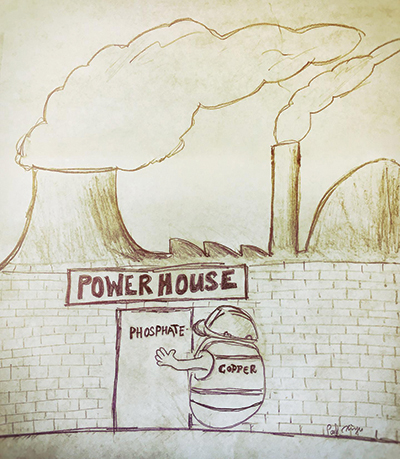JBC: Scientists fill in a piece of the copper transport puzzle
Researchers have identified the protein that carries copper into mitochondria, where copper is required for the functioning of the cell’s energy conversion machinery. The discovery, the Journal of Biological Chemistry, fills in a piece of the puzzle of how copper is distributed and used in the cell.
 Mitochondria, the powerhouses of the cell, need copper to produce energy. Copper enters the mitochondria through a previously identified phosphate transporter.Courtesy of Paul Cobine and Xinyu Zhu/Auburn University Humans acquire copper in trace amounts from food. Despite its low levels, copper is essential for the functioning of numerous important enzymes, such as some of those involved in synthesizing collagen and neurotransmitters. Notably, copper is required for building cytochrome c oxidase, known as COX, a large protein complex in mitochondria that forms the last step of the electron transport chain, which harvests energy for the production of ATP, the energy currency of the cell.
Mitochondria, the powerhouses of the cell, need copper to produce energy. Copper enters the mitochondria through a previously identified phosphate transporter.Courtesy of Paul Cobine and Xinyu Zhu/Auburn University Humans acquire copper in trace amounts from food. Despite its low levels, copper is essential for the functioning of numerous important enzymes, such as some of those involved in synthesizing collagen and neurotransmitters. Notably, copper is required for building cytochrome c oxidase, known as COX, a large protein complex in mitochondria that forms the last step of the electron transport chain, which harvests energy for the production of ATP, the energy currency of the cell.
of Auburn University and his collaborator at the University of Saskatchewan have been working for more than 10 years on understanding how copper is used to assemble COX. One basic question was, how does copper get across the membranes in mitochondria?
“To get (copper) to the correct address (in the cell) without interfering with other proteins, or disrupting other targets that have a high chance of binding copper, is a herculean delivery effort,” Cobine said. “This is akin to finding your way to an exit in a crowded bar without touching the other people or getting redirected. Then after finding the exit, you must make sure you go through the right door.”
The researchers used multiple lines of evidence to arrive at an answer: Copper is transported within mitochondria by a protein called SLC25A3. This discovery was surprising because SLC25A3 was already known to transport phosphate, a negatively charged ion, whereas copper ions carry a positive charge. The researchers speculate that the copper ions may need to bind to another partner, forming a negatively charged complex, for SLC25A3 to be able to transport it. The next question they want to address is how the transporter distinguishes between its different types of cargo.
Previously known mutations in the gene encoding SLC25A3 are responsible for poorly understood genetic disorders involving dysfunctional heart and muscle fibers, leading to enlarged hearts and low muscle tone. As these tissues require large amounts of energy, it seems plausible that these patients’ symptoms could be related to insufficient copper transport in mitochondria.
These symptoms “all sound like they could be related to both ATP production and cytochrome c oxidase,” Cobine said.
With the discovery of the copper transport pathway within mitochondria, the health effects of copper can be studied in more detail because researchers will be able to distinguish the effects of copper on COX from the other pathways it’s involved in.
“If we don’t deal with copper properly throughout our life, what are the metabolic diseases that come up?” Cobine asks. “Now we have the ability to look at what happens when you lose mitochondrial copper at different (developmental) stages.”
Enjoy reading ASBMB Today?
Become a member to receive the print edition four times a year and the digital edition monthly.
Learn moreGet the latest from ASBMB Today
Enter your email address, and we’ll send you a weekly email with recent articles, interviews and more.
Latest in Science
Science highlights or most popular articles

How scientists identified a new neuromuscular disease
NIH researchers discover Morimoto–Ryu–Malicdan syndrome, after finding shared symptoms and RFC4 gene variants in nine patients, offering hope for faster diagnosis and future treatments.

Unraveling cancer’s spaghetti proteins
MOSAIC scholar Katie Dunleavy investigates how Aurora kinase A shields oncogene c-MYC from degradation, using cutting-edge techniques to uncover new strategies targeting “undruggable” molecules.

How HCMV hijacks host cells — and beyond
Ileana Cristea, an ASBMB Breakthroughs webinar speaker, presented her research on how viruses reprogram cell structure and metabolism to enhance infection and how these mechanisms might link viral infections to cancer and other diseases.

Understanding the lipid link to gene expression in the nucleus
Ray Blind, an ASBMB Breakthroughs speaker, presented his research on how lipids and sugars in the cell nucleus are involved in signaling and gene expression and how these pathways could be targeted to identify therapeutics for diseases like cancer.

Receptor antagonist reduces age-related bone loss in mice
Receptor antagonist reduces bone loss and promotes osteoblast activity in aging mice, highlighting its potential to treat osteoporosis. Read more about this recent JBC paper.

Engineered fusion protein targets kiwifruit pathogen
Synthetic protein selectively kills kiwifruit pathogen, offering a promising biocontrol strategy for agriculture. Read more about this recent JBC paper.

.jpg?lang=en-US&width=300&height=300&ext=.jpg)